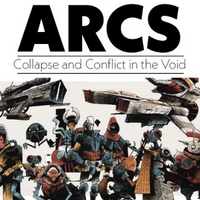08 January 2023
|
What’s a little pickpocketing between friends?
Words by Richard Jansen-Parkes Artwork from Journeys beyond the Radiant Citadel courtsey of Wizards of the Coast
One of the (many, many) nice things about getting paid to write about RPGs is being able to sample countless different rulesets. While they aren’t all solid gold from end to end, it’s rare to encounter a game that doesn’t have at least one clever idea or innovative rule.
Sometimes, these interesting rules only really work in their original setting. For example, the Altered Carbon RPG’s system for switching out physical stats by downloading your brain into a new body rather relies on the setting’s love of digital consciousness. It probably wouldn’t work quite so neatly in a gritty detective campaign.
In many cases, however, a game’s most useful ideas can be yoinked out of their original framework and applied to a whole new system. You sometimes need a bit of hand-waving to get things to work perfectly, of course, but this is a small price to pay for innovation.
This month, we’re going to run through a handful of some of the best rules to borrow from established RPGs and stick into your current game.
MINIONS: D&D 4E
Dungeons & Dragons Fourth Edition came under a fair bit of flak on release, with purists objecting to its gamified language and drawn-out combat encounters. However, now that time has healed the wounds that once split the D&D community – or, at least, scabbed them over – we can begin to recognise some of its more innovative ideas.
Among these are the bloodied condition, which provided an easy way for special abilities to kick in when monsters hit half health, and the decision to provide enemies with distinct battlefield roles. Fourth Edition’s stand-out mechanic, however, has to be ‘minions’.
Minions are a category of enemies that dealt high damage but only had a single hit point. Every successful attack, whether the swing of a sword or the blast of a fireball, was enough to take them out of the fight.
This paper-thin stock of health meant they could serve two purposes. Firstly, they were something a DM could throw into an upcoming battle without worrying too much about upsetting the balance. Secondly, and most importantly, they helped to amp up the cinematic feel of any encounter. A table full of minions replicated the feel of Star Wars’ rebel heroes blasting their way through a legion of stormtroopers, or Lord of the Rings’ fellowship racking up a pile of orcish multikills. It made the players feel like stone-cold badasses.
One of the nice things about minions is that they’re easy to introduce into virtually any combat-heavy RPG, including D&D Fourth Edition’s own successor. Just be careful not to throw too many into the fray if your party lacks fireballs.
XP ON FAILURE: POWERED BY THE APOCALYPSE
People don’t like failing at things. As much as we like to talk a big game about enjoying the way it can shape a story, and how winning all the time isn’t really much fun, it still hurts when the dice decide to spit in our face and make our character screw up.
This bad feeling - not to mention the more tangible consequences like missing HP and alerted guards - can sometimes push players into avoiding even potential failures like the plague. It encourages people to play cautiously and conservatively, rather than pushing for adventure and rolling with the punches.
Most PbtA games, including Monster of the Week and Root RPG, head off this problem by tying failure into progression. The best way to level up in these systems is to try risky things and allow yourself to fail, with each unsuccessful dice roll earning you 1XP.
This works wonderfully with the narrative-driven nature of PbtA, as well as the fact that GM’s are encouraged to only ask for a roll when failure has real consequences. This makes it almost impossible to try and cheat the system by repeatedly failing at minor tasks, and ensures that the inevitable result is exciting.
You can work this same feeling into more traditional game systems by providing bonus XP - or whatever your game’s equivalent is – for trying and failing at something exciting and good for the story. It can require a bit of calibration, but it should be just enough to feel meaningful.
SUCCESS AT A COST: FATE
Just as players want to avoid failure, sometimes they really, really want to succeed. Maybe they know that a successful roll will fulfil their character’s lifelong dream. Maybe they know that it will stave off their worst possible nightmare.
In either case, the result is the same. They’ll do anything to succeed.
Assuming that you aren’t personally open to bribery, one way to guarantee a positive result is by using FATE’s ‘success at a cost’ mechanic. This is pretty much exactly what it sounds like. It’s a formalised system for allowing the GM to allow any roll to succeed so long as the character pays an agreed-upon price.
This might mean allowing a character to make their leap across the bottomless pit but at the cost of having their sword-belt rip as they scrabble over the lip, sending their prized weapon tumbling into the void. It could mean allowing the hacker to break into the corporate net but exposing themselves to tracing programs. It might even mean allowing the rogue to slit the throat of the guard that has them pinned to the wall, at the cost of a life-long grudge from the guard’s well-trained sister.
One of the key elements to keeping the system feeling fair and above board is its iron-clad requirement that both parties approve any deal. The player needs to be able to walk away from the exchange if the cost is too high, while the GM is never obligated to offer success if they don’t feel it would make sense in the world or the story - you can’t lift a mountain just because you’re willing to stub a toe afterward.
FLASHBACKS: BLADES IN THE DARK
It’s amazing how long RPG groups can spend planning a simple mission. Given the chance, they will happily spend the entire night ensuring that every phase of a plan is thought out and provisioned for.
This can be enjoyable every now and then, but if you’re running a game with a lot of complex infiltrations, it’s a bit of a drag on the pacing. That’s why you can shortcut many of the more fiddly aspects of planning by allowing Blades in the Dark’s ‘Flashbacks’.
These flashbacks should be familiar to anyone who has ever seen a heist movie. They’re the bits that crop up when we think the heroes are about to fail and show that – actually – this was part of their plan all along.
The unexpected cop? One of the team in a false moustache. The CCTV cameras? Well, last night the hacker set them up to record in a loop so no need to worry. The power cut? No worries; the mastermind planned it weeks ago by pretending to be a maintenance worker.
In Blades in the Dark, this translates into allowing the players to retroactively plan things out and prepare. If the team runs into a guard, one of them might invoke a flashback that shows them slipping over a bag of clinking coins the previous evening. If they suddenly realise they need a grappling hook, another player might flashback to the time they were planning the job and retroactively deduct the cost of their brand new gear from their coffers.
The cost of these flashbacks depends on how complex the task is, with more complex bits of planning incurring a higher stress cost. Unfortunately, this isn’t a mechanic that translates incredibly well into many mainstream systems, so you may need to be a little creative if you want to implement them into your home game.
Personally, I usually hand out a couple of tokens to each player before they go on any heist or heist-adjacent mission. Each token can be traded in for a reasonable bit of planning without the need to roll.
Looking for more?

This review came from Tabletop Gaming Magazine, which is home to all of the latest and greatest tabletop goodness. Whether you're a board gamer, card gamer, wargamer, RPG player or all of the above, find your copy here.
Get your magazine hereRead More...

If you want to read more about one of the most hotly anticipated games of the year, check out our interview with Cole Wehrle on ARCS! A new game from the designer of Root and Oath, and we've got all you need to know.
To infinity and beyond
Sometimes we may include links to online retailers, from which we might receive a commission if you make a purchase. Affiliate links do not influence editorial coverage and will only be used when covering relevant products







